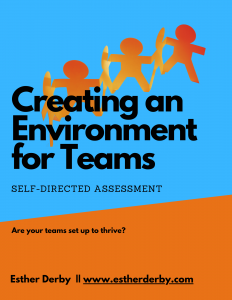When I work with a project team on a retrospective, one of the first things I attend to is the safety of the group.
I define safety as the ability to speak your truth without fear of ridicule, rejection, or retribution. Once in a while, someone has a strong reaction to the idea of safety. Usually the response is about how naive the notion is — and we’re not at work to hold hands and sing kumbaya.
I agree, we’re not at work to hold hands and sing kumbaya. And, I believe that safety is an important factor in productivity.
Here’s a little story (a true story, thought details have been changed) about safety at work:
A small software company hired a new VP (I’ll refer to him as Jim) to revitalize a
flagging product. Jim has a marketing and sales background and the thinking was he’d bring
a strong business focus and marketing savvy to the company.
Jim has re-negotiated vendor relationships, promised customers additional releases, and overhauled the compensation structure for both employees and contractors working on the product. He’s reduce costs by not hiring replacements for people who’ve left and he’s laid off a couple more people. The remaining members of the team have sucked up the work.
The CEO has always been a has been hands-off guy and since Jim started he’s been pretty removed from the day-to-day.
The dev team has been luke-warm to Jim’s changes. Some of Jim’s changes make sense, but it seems like, even though he has a marketing background, he doesn’t understand the market for this product.
The dev team is worried about their ability to meet the new release schedule. They’re concerned about the work load, and they’re concerned about quality because people are working so many extra hours to cover the extra work.
Several developers have tried to talk to Jim about their concerns. Jim gets angry and responds with phrases like, “you’re part of the problem!” and “I don’t want to hear about problems, I want to hear how to make my ideas work!”
The developers have been wondering if the CEO is aware of what’s happening on their team. They don’t want to go over the new guys head…They have an uneasy feeling he’d see it as a threat.
Last week the CEO casually asked one of the developers, Randy, how things were going. He got an earful.
The CEO was justifiably concerned and met with Jim to find out what was going on.
Two days later, Jim fired Randy for having a “bad attitude.”
So much for safety.
Morale was poor before the firing, now its in the pits.
Jim (and the CEO) have virtually ensured that they won’t hear anything that doesn’t toe Jim’s party line. The developers are keeping their heads down, and focusing on narrowly defined tasks… when they’re not looking for new jobs, complaining about Jim, or pining for the way things used to be.
The developers see problems brewing, but they aren’t going to raise issues or point out problems. They’re not dummies…They don’t want to be punished.
Safety is a business issue.
People who feel safe are more productive and have better morale.
Workplaces are safe have better information flow.
When safety goes, productivity goes down and managers destroy a crucial information channel.



Trackbacks/Pingbacks